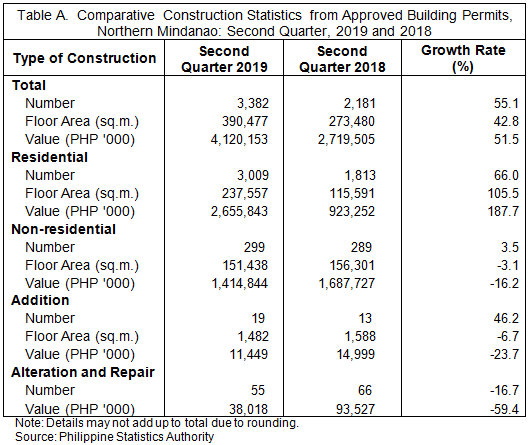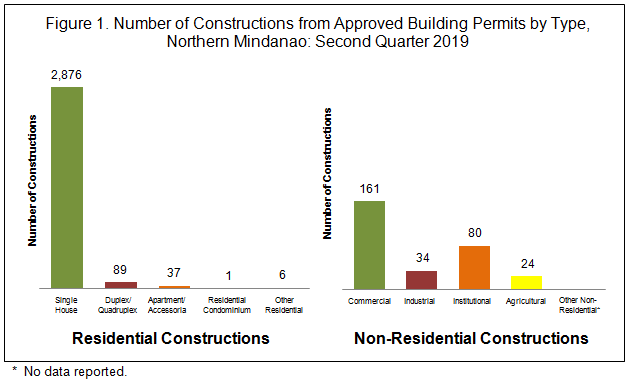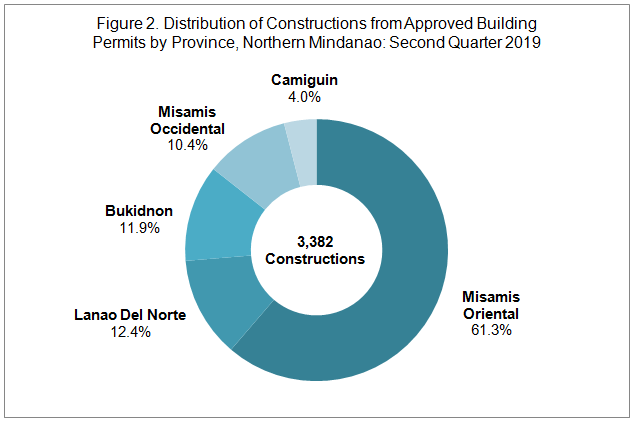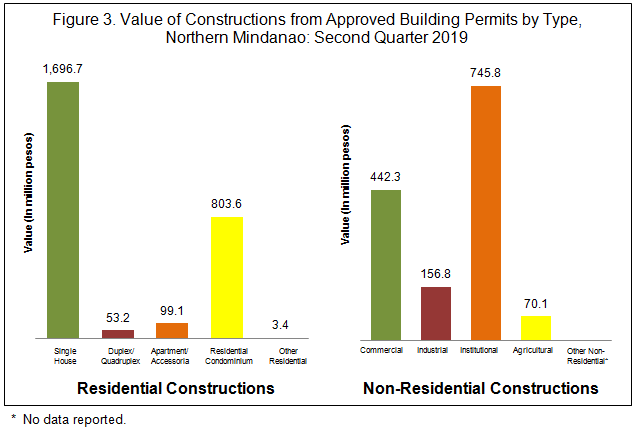
Number of constructions up by 55.1 percent year-on-year in the second quarter of 2019
The total number of constructions in the second quarter of 2019 totaled to 3,382, equivalent to a 55.1 percent increase from 2,181 constructions recorded in the same quarter of 2018. (Table A)
Residential has the highest number of constructions
By type of construction, residential reported the highest number of 3,009 constructions or 89.0 percent of the total. This reflects a 66.0 percent growth from its corresponding number in 2018. Majority (2,876 or 95.6%) of the residential constructions were single-type houses. (Table A and Figure 1)
Similarly, the number of non-residential constructions was registered at 299 which accounted for 8.8 percent of the total constructions. This shows a 3.5 percent growth from the 289 non-residential constructions recorded in the same period of 2018. More than half of the non-residential constructions were comprised of commercial buildings (161 or 53.8%).
The number of additions to existing structures posted at 19 (0.6%), portrays a 46.2 percent growth from the same quarter a year ago. On the other hand, the combined number of alterations and repairs of existing structures at 55 (1.6%), declined by 16.7 percent from the same period a year ago.

Number of constructions is highest in Misamis Oriental
In terms of number of constructions, Misamis Oriental ranked first with 2,073 constructions or 61.3 percent share to total. Lanao del Norte with 419 constructions (12.4%) ranked next, followed by Bukidnon (11.9%), Misamis Occidental (10.4%), and Camiguin (4.0%). (Figure 2)

Value of constructions grows by 51.5 percent
In the second quarter of 2019, the total value of constructions amounted to PhP 4.1 billion, an increase of 51.5 percent from the same quarter a year ago. (Table A)
Among types of constructions, residential posted the highest value at PhP 2.7 billion (64.5%), almost thrice the value in the same quarter a year ago. Single-type houses (PhP 1.7 billion) registered the highest value among residential constructions.
On the other hand, non-residential building constructions, valued at PhP 1.4 billion, accounted for 34.3 percent of the total value. This shows a contraction of 16.2 percent from the PhP 1.7 billion construction value posted in the same quarter a year ago. Institutional building constructions (PhP 745.8 million) recorded the highest value among non-residential constructions. (Figure 3)

Average cost of residential constructions up by 40.0 percent
The average cost per square meter (sq.m.) for all constructions under consideration was valued at PhP 10,552, an increase of 6.1 percent from its corresponding cost (PhP 9,944/sq.m.) in the same quarter of the previous year. (Table A.1.)
Among types of constructions, residential had the highest average cost per square meter (PhP 11,180/sq.m.) which is equivalent to a 40.0 percent increase from the previous year’s corresponding average cost. This was followed by non-residential constructions (PhP 9,343/sq.m.) and additions to existing structures (PhP 7,725/sq.m.) which contracted by 13.5 percent and 18.2 percent, respectively, from their corresponding average cost from a year ago.
RUBEN D. ABARO, JR., CESE
Regional Director
For further inquiries, you may contact:
Statistical Operations & Coordination Division
Philippine Statistics Authority Regional Statistical Service Office 10
2nd Floor, Bldg. 4, Pride Rock Business Park
Gusa Highway, Cagayan de Oro City
Email: psaregion10@gmail.com
Telefax: (088) 856-4778
TECHNICAL NOTES
CONSTRUCTION STATISTICS FROM APPROVED BUILDING PERMITS
This Special Release presents the preliminary data on construction statistics from approved building permits for the second quarter of 2019.
Scope and Coverage
Construction statistics presented in this special release are based on approved building permits on new constructions and additions, alterations and repairs of existing residential and non-residential buildings and other structures which are proposed to be constructed in all cities/municipalities of the region.
Sources of Information
Construction statistics are generated from approved building permits as well as from the demolition and fencing permits collected every month by PSA field personnel from the Offices of Local Building Officials (LBOs).
Limitations
- Data on building constructions are based on approved applications for construction during the reference period and not on the construction work completed during the reference period.
- The completeness of construction data relies on the approved applications filed with the LBOs. Hence, building constructions without approved building permits are excluded in the tabulation of data.
Definition of Terms (Adopted from the Revised and Updated IRR of the National Building Code)
Building permit is a written authorization granted by the LBO to an applicant allowing him to proceed with the construction of a specific project after plans, specifications and other pertinent documents have been found to be in conformity with the National Building Code (PD 1096).
Building refers to any independent, free-standing structure comprised of one or more rooms or other spaces, covered by a roof and enclosed with external walls or dividing walls, which extend from the foundation to the roof.
Construction refers to all on-site work done from site preparation, excavation, foundation, assembly of all the components and installation of utilities, machineries and equipment of buildings/structures.
Residential building is a building for which its major parts or more than half of its gross floor area is built for dwelling purposes. This type of building can be of the single type, duplex, apartment and/or accessoria and residential condominium.
Single house is a complete structure intended for a single family or household, i.e., bungalow, 2-storey house, nipa hut, etc.
Duplex house is a structure intended for two households, with complete living facilities for each; it is a single structure divided into two dwelling units by a wall extending from the floor to the ceiling.
Apartment is a structure, usually of two storeys, made up of independent living quarters, with independent entrances from internal walls and courts.
Accessoria is a one or two-floor structure divided into several dwelling units, each dwelling unit having its own separate entrance from the outside.
Residential condominium is a structure, usually of several storeys, consisting of multiple dwelling units.
Other residential construction consists of school or company staff houses, living quarters for drivers and maids, and guardhouses.
Non-residential building includes commercial, industrial, agricultural and institutional buildings.
Commercial buildings refer to office buildings and all buildings which are intended for use primarily in wholesale, retail and service trades; i.e., stores, hotels, restaurants, banks, disco houses, etc.
Industrial buildings are all buildings used to house the production, assembly and warehousing activities of industrial establishments; i.e., factories, plants, mills, repair shops, machine shops, printing press, storage plant, electric generating plants.
Institutional buildings are buildings which primarily engaged in providing educational instructions and hospital/health care; ports, airports and other government buildings; i.e. school, museums, libraries, sanitaria, churches, hospitals.
Agricultural buildings are buildings used to house livestock, plants and agricultural products such as barn, poultry house, piggeries, stables, greenhouses and grain mill.
Other non-building constructions include cemetery structures, street furniture, waiting sheds, communication towers, etc.
Addition refers to any new construction which increases the height or area of an existing building/structure.
Repair is a remedial work done on any damaged or deteriorated portion/s of a building/structure to restore its original condition.
Renovation is any physical change made on structures to increase the value, quality and to improve the aesthetic.
Alteration is a construction in a building/structure involving changes in the materials used, partitioning and location/size of openings, structural parts, existing utilities and equipment but does not increase the overall area thereof.
Conversion is a change in the use or occupancy of structure or any portion thereof, which has different requirements.
Demolitions refer to the systematic dismantling or destruction of a building/structure, in whole or in part.
Street furniture are street structures consisting of monuments, waiting sheds, benches, plant boxes, lampposts, electric poles and telephone poles.
Floor area of building refers to the sum of the area of each floor of the building measured to the outer surface of the outer walls including the area of lobbies, cellars, elevator shafts and all communal spaces in multi-dwellings. Areas of balconies are excluded.
Total value of construction refers to the sum of the cost of building, electrical, mechanical, plumbing, and others. The value is derived from the approved building permit and represents the estimated value of the building or structure when completed.

